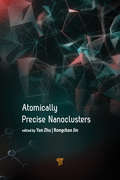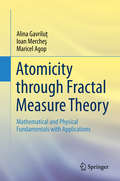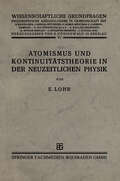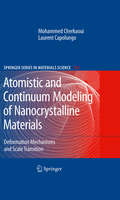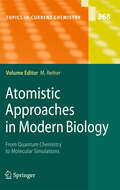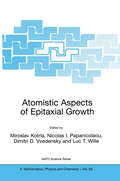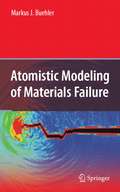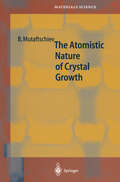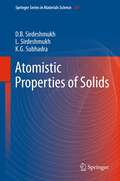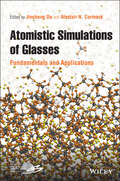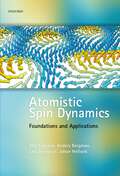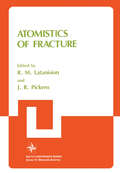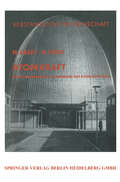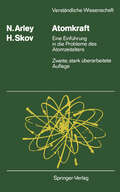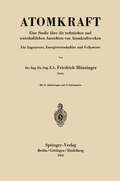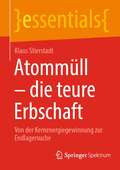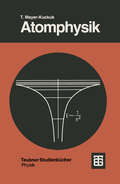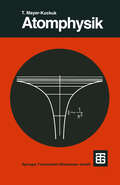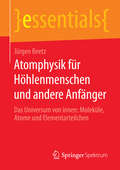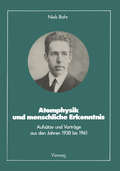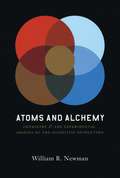- Table View
- List View
Atomically Precise Nanoclusters
by Rongchao Jin Yan ZhuThe primary goal of nanotechnology is to achieve nanoscale materials and devices with atomic precision. Toward this goal, breakthroughs have recently been made in the solution-phase synthesis and applications of atomically precise nanoclusters. This book presents the exciting progress in this new research field. The chapters are contributed by leading experts of the field and cover the synthetic methods, atomic structures, electronic and optical properties, and catalytic applications of noble metal nanoclusters. Such new nanocluster materials offer exciting opportunities for chemists and physicists to understand the fundamental science of nanoclusters, especially the atomic-level structure–property correlation and design of new materials, as well as for developing a range of applications including catalysis, biomedicine, sensing, imaging, optics, and energy conversion. The book will be of interest to readers and researchers in nanotechnology, nanochemistry, catalysis, and computational chemistry, as well as practitioners in industry R&D for new materials. It is written to be accessible to undergraduate and graduate students and, therefore, is an excellent teaching material.
Atomically Precise Nanoclusters
by Yan Zhu; Rongchao JinThe primary goal of nanotechnology is to achieve nanoscale materials and devices with atomic precision. Toward this goal, breakthroughs have recently been made in the solution-phase synthesis and applications of atomically precise nanoclusters. This book presents the exciting progress in this new research field. The chapters are contributed by leading experts of the field and cover the synthetic methods, atomic structures, electronic and optical properties, and catalytic applications of noble metal nanoclusters. Such new nanocluster materials offer exciting opportunities for chemists and physicists to understand the fundamental science of nanoclusters, especially the atomic-level structure–property correlation and design of new materials, as well as for developing a range of applications including catalysis, biomedicine, sensing, imaging, optics, and energy conversion. The book will be of interest to readers and researchers in nanotechnology, nanochemistry, catalysis, and computational chemistry, as well as practitioners in industry R&D for new materials. It is written to be accessible to undergraduate and graduate students and, therefore, is an excellent teaching material.
Atomicity through Fractal Measure Theory: Mathematical and Physical Fundamentals with Applications
by Alina Gavriluţ Ioan Mercheş Maricel AgopThis book presents an exhaustive study of atomicity from a mathematics perspective in the framework of multi-valued non-additive measure theory. Applications to quantum physics and, more generally, to the fractal theory of the motion, are highlighted. The study details the atomicity problem through key concepts, such as the atom/pseudoatom, atomic/nonatomic measures, and different types of non-additive set-valued multifunctions. Additionally, applications of these concepts are brought to light in the study of the dynamics of complex systems.The first chapter prepares the basics for the next chapters. In the last chapter, applications of atomicity in quantum physics are developed and new concepts, such as the fractal atom are introduced. The mathematical perspective is presented first and the discussion moves on to connect measure theory and quantum physics through quantum measure theory. New avenues of research, such as fractal/multifractal measure theory with potential applications in life sciences, are opened.
Atomismus und Kontinuitätstheorie in der Neuzeitlichen Physik
by Dr. phil. LohrDieser Buchtitel ist Teil des Digitalisierungsprojekts Springer Book Archives mit Publikationen, die seit den Anfängen des Verlags von 1842 erschienen sind. Der Verlag stellt mit diesem Archiv Quellen für die historische wie auch die disziplingeschichtliche Forschung zur Verfügung, die jeweils im historischen Kontext betrachtet werden müssen. Dieser Titel erschien in der Zeit vor 1945 und wird daher in seiner zeittypischen politisch-ideologischen Ausrichtung vom Verlag nicht beworben.
Atomistic and Continuum Modeling of Nanocrystalline Materials: Deformation Mechanisms and Scale Transition (Springer Series in Materials Science #112)
by Laurent CapolungoAtomistic and Continuum Modeling of Nanocrystalline Materials develops a complete and rigorous state-of-the-art analysis of the modeling of the mechanical behavior of nanocrystalline (NC) materials. Among other key topics, the material focuses on the novel techniques used to predict the behavior of nanocrystalline materials. Particular attention is given to recent theoretical and computational frameworks combining atomistic and continuum approaches. Also, the most relevant deformation mechanisms governing the response of nanocrystalline materials are addressed and discussed in correlation with available experimental data.
Atomistic Approaches in Modern Biology: From Quantum Chemistry to Molecular Simulations (Topics in Current Chemistry #268)
by Markus ReiherThis series presents critical reviews of the present position and future trends in modern chemical research. It contains short and concise reports on chemistry, each written by the world renowned experts. This series remains valid and useful after 5 or 10 years. More information as well as the electronic version of the whole content available at: springerlink.com.
Atomistic Aspects of Epitaxial Growth (NATO Science Series II: Mathematics, Physics and Chemistry #65)
by Dimitri Vvedensky Luc T. Wille Miroslav Kotrla Nicolas I. PapanicolaouEpitaxial growth lies at the heart of a wide range of industrial and technological applications. Recent breakthroughs, experimental and theoretical, allow actual atom-by-atom manipulation and an understanding of such processes, opening up a totally new area of unprecedented nanostructuring. The contributions to Atomistic Aspects of Epitaxial Growth are divided into five main sections, taking the reader from the atomistic details of surface diffusion to the macroscopic description of epitaxial systems. many of the papers contain substantial background material on theoretical and experimental methods, making the book suitable for both graduate students as a supplementary text in a course on epitaxial phenomena, and for professionals in the field.
Atomistic Modeling of Materials Failure
by Markus J. BuehlerThis is an introduction to molecular and atomistic modeling techniques applied to fracture and deformation of solids, focusing on a variety of brittle, ductile, geometrically confined and biological materials. The overview includes computational methods and techniques operating at the atomic scale, and describes how these techniques can be used to model cracks and other deformation mechanisms. The book aims to make new molecular modeling techniques available to a wider community.
The Atomistic Nature of Crystal Growth (Springer Series in Materials Science #43)
by Boyan MutaftschievThis textbook is for graduate students and young scientists, who are looking for an introduction to the physics and physical chemistry of crystal growth and nucleation phenomena.
Atomistic Properties of Solids (Springer Series in Materials Science #147)
by Dinker B. Sirdeshmukh Lalitha Sirdeshmukh K.G. SubhadraThe book deals with atomistic properties of solids which are determined by the crystal structure, interatomic forces and atomic displacements influenced by the effects of temperature, stress and electric fields. The book gives equal importance to experimental details and theory. There are full chapters dedicated to the tensor nature of physical properties, mechanical properties, lattice vibrations, crystal structure determination and ferroelectricity. The other crystalline states like nano-, poly-, liquid- and quasi crystals are discussed. Several new topics like nonlinear optics and the Rietveld method are presented in the book. The book lays emphasis on the role of symmetry in crystal properties. Comprehensiveness is the strength of the book; this allows users at different levels a choice of chapters according to their requirements.
Atomistic Simulations of Glasses: Fundamentals and Applications
by Jincheng Du Alastair CormackA complete reference to computer simulations of inorganic glass materials In Atomistic Simulations of Glasses: Fundamentals and Applications, a team of distinguished researchers and active practitioners delivers a comprehensive review of the fundamentals and practical applications of atomistic simulations of inorganic glasses. The book offers concise discussions of classical, first principles, Monte Carlo, and other simulation methods, together with structural analysis techniques and property calculation methods for the models of glass generated from these atomistic simulations, before moving on to practical examples of the application of atomistic simulations in the research of several glass systems. The authors describe simulations of silica, silicate, aluminosilicate, borosilicate, phosphate, halide and oxyhalide glasses with up-to-date information and explore the challenges faced by researchers when dealing with these systems. Both classical and ab initio methods are examined and comparison with experimental structural and property data provided. Simulations of glass surfaces and surface-water reactions are also covered. Atomistic Simulations of Glasses includes multiple case studies and addresses a variety of applications of simulation, from elucidating the structure and properties of glasses for optical, electronic, architecture applications to high technology fields such as flat panel displays, nuclear waste disposal, and biomedicine. The book also includes: A thorough introduction to the fundamentals of atomistic simulations, including classical, ab initio, Reverse Monte Carlo simulation and topological constraint theory methods Important ingredients for simulations such as interatomic potential development, structural analysis methods, and property calculations are covered Comprehensive explorations of the applications of atomistic simulations in glass research, including the history of atomistic simulations of glasses Practical discussions of rare earth and transition metal-containing glasses, as well as halide and oxyhalide glasses In-depth examinations of glass surfaces and silicate glass-water interactions Perfect for glass, ceramic, and materials scientists and engineers, as well as physical, inorganic, and computational chemists, Atomistic Simulations of Glasses: Fundamentals and Applications is also an ideal resource for condensed matter and solid-state physicists, mechanical and civil engineers, and those working with bioactive glasses. Graduate students, postdocs, senior undergraduate students, and others who intend to enter the field of simulations of glasses would also find the book highly valuable.
Atomistic Simulations of Glasses: Fundamentals and Applications
by Jincheng Du Alastair N. CormackA complete reference to computer simulations of inorganic glass materials In Atomistic Simulations of Glasses: Fundamentals and Applications, a team of distinguished researchers and active practitioners delivers a comprehensive review of the fundamentals and practical applications of atomistic simulations of inorganic glasses. The book offers concise discussions of classical, first principles, Monte Carlo, and other simulation methods, together with structural analysis techniques and property calculation methods for the models of glass generated from these atomistic simulations, before moving on to practical examples of the application of atomistic simulations in the research of several glass systems. The authors describe simulations of silica, silicate, aluminosilicate, borosilicate, phosphate, halide and oxyhalide glasses with up-to-date information and explore the challenges faced by researchers when dealing with these systems. Both classical and ab initio methods are examined and comparison with experimental structural and property data provided. Simulations of glass surfaces and surface-water reactions are also covered. Atomistic Simulations of Glasses includes multiple case studies and addresses a variety of applications of simulation, from elucidating the structure and properties of glasses for optical, electronic, architecture applications to high technology fields such as flat panel displays, nuclear waste disposal, and biomedicine. The book also includes: A thorough introduction to the fundamentals of atomistic simulations, including classical, ab initio, Reverse Monte Carlo simulation and topological constraint theory methods Important ingredients for simulations such as interatomic potential development, structural analysis methods, and property calculations are covered Comprehensive explorations of the applications of atomistic simulations in glass research, including the history of atomistic simulations of glasses Practical discussions of rare earth and transition metal-containing glasses, as well as halide and oxyhalide glasses In-depth examinations of glass surfaces and silicate glass-water interactions Perfect for glass, ceramic, and materials scientists and engineers, as well as physical, inorganic, and computational chemists, Atomistic Simulations of Glasses: Fundamentals and Applications is also an ideal resource for condensed matter and solid-state physicists, mechanical and civil engineers, and those working with bioactive glasses. Graduate students, postdocs, senior undergraduate students, and others who intend to enter the field of simulations of glasses would also find the book highly valuable.
Atomistic Spin Dynamics: Foundations and Applications
by Olle Eriksson Anders Bergman Lars Bergqvist Johan HellsvikThe purpose of this book is to provide a theoretical foundation and an understanding of atomistic spin-dynamics (ASD), and to give examples of where the atomistic Landau-Lifshitz-Gilbert equation can and should be used. As argued in the text, a description of magnetism in an atomistic way is very natural and allows for an interpretation of experimental results in a clear and deep way. This description also allows for calculations, from first principles, of all parameters needed to perform the spin-dynamics simulations, without using experimental results as input to the simulations. As shown in the book, we are now at a very exciting situation, where it is possible to perform accurate and efficient atomistic simulations on a length- and time-scale which is balancing on the edge of what is experimentally possible. In this way, ASD simulations can both validate and be validated by state-of-the art experiments, and ASD simulations also have the possibility to act as a predictive tool that is able to explain the magnetization dynamics in experimentally inaccessible situations. The purpose of this book has been to communicate technically relevant concepts. An even larger motivation is to communicate an inspiration to magnetism and magnetization dynamics, and the emerging technological fields that one may foresee, e.g. in magnonics, solitonics and skyrmionics.
Atomistics of Fracture (Nato Conference Series #5)
by R. M. Latanison J. R. PickensIt is now more than 100 years since certain detrimental effects on the ductility of iron were first associated with the presence of hydrogen. Not only is hydrogen embrittlement still a major industri al problem, but it is safe to say that in a mechanistic sense we still do not know what hydrogen (but not nitrogen or oxygen, for example) does on an atomic scale to induce this degradation. The same applies to other examples of environmentally-induced fracture: what is it about the ubiquitous chloride ion that induces premature catastrophic fracture (stress corrosion cracking) of ordinarily ductile austenitic stainless steels? Why, moreover, are halide ions troublesome but the nitrate or sulfate anions not deleterious to such stainless steels? Likewise, why are some solid metals embrit tled catastrophically by same liquid metals (liquid metal embrit tlement) - copper and aluminum, for example, are embrittled by liquid mercury. In short, despite all that we may know about the materials science and mechanics of fracture on a macroscopic scale, we know little about the atomistics of fracture in the absence of environmental interactions and even less when embrittlement phe nomena such as those described above are involved. On the other hand, it is interesting to note that physical chemists and surface chemists also have interests in the same kinds of interactions that occur on an atomic scale when metals such as nickel or platinum are used, for example, as catalysts for chemical reactions.
Atomkraft: Eine Einführung in die Probleme des Atomzeitalters (Verständliche Wissenschaft #73)
by N. Arley H. SkovAtomkraft: Eine Einführung in die Probleme des Atomzeitalters (Verständliche Wissenschaft #73)
by N. Arley H. SkovAtomkraft: Eine Einführung in die Probleme des Atomzeitalters (Verständliche Wissenschaft #73)
by Niels Arley Helge SkovDem nach der Tschernobyl-Katastrophe stark angewachsenen Informationsbedürfnis über die Möglichkeiten und Risiken der Kernkraft-Ausnutzung trägt diese Neuauflage Rechnung. In verständlicher Form wird in die technischen, militärischen, medizinischen und biologischen Probleme des Atomzeitalters eingeführt. Besondere Beachtung findet dabei das Dilemma der modernen Technik, häufig mit der Lösung alter Probleme neue zu kreieren.
Atomkraft: Eine Studie über die technischen und wirtschaftlichen Aussichten von Atomkraftwerken
by Friedrich MünzingerDiese Studie ist wahrscheinlich das erste Buch, das versucht, die zahlreichen bisher vorgeschlagenen Bauarten von Reaktoren (Atom meilern) systematisch zu ordnen und auf ihre Eignung für Elektrizitäts werke in technischer und wirtschaftlicher Beziehung kritisch zu prüfen. Ein eigenartiger Zufall will es, daß ich vor 35 Jahren über eine andere gleichfalls in Amerika entwickelte Neuerung, nämlich Kohlenstaub feuerungen für ortsfeste Dampfkessel, auch das erste Buch heraus gebracht habe. Mein ursprüngliches Bedenken, vorliegende Abhandlung zu schreiben, weil Deutschland bisher an der Entwicklung von Reaktoren nicht mit arbeiten konnte, wurde schließlich durch die Überlegung überwunden, daß es für die große Zahl derer, denen die ausländische Fachliteratur nicht zur Verfügung steht, zur Zeit sehr schwer ist, sich ein einiger maßen klares Bild vom Stand der Dinge zu machen. Die in deut schen Zeitschriften erschienenen, über ausländische Erfahrungen be richtenden Veröffentlichungen beschränken sich nämlich - ähnlich wie manche der betreffenden Originalarbeiten - im allgemeinen auf reine Beschreibung einzelner Reaktoren, wodurch man nur schwer erkennen kann, was wichtig ist und was nicht. Dieser Mißstand dürfte sich noch verstärken, weil infolge der Lockerung der Geheimhaltungsvorschriften die Zahl der einschlägigen amerikanischen Veröffentlichungen in den letzten Monaten stark angewachsen ist. Vorliegende Abhandlung möchte daher als eine Art Führer auf diesem neuartigen Gebiete der Technik dienen und das Vertrautwerden mit der verwickelten Materie erleich tern, damit Deutschland den großen Vorsprung des Auslandes schnell aufholen kann.
Atommüll - die teure Erbschaft: Von der Kernenergiegewinnung zur Endlagersuche (essentials)
by Klaus StierstadtBei der Energiegewinnung aus Atomkernen entstehen radioaktive Abfälle. Deren radioaktive Strahlung ist für belebte Materie außerordentlich schädlich. Solche Strahlenschäden werden besprochen und mit der natürlichen Strahlenbelastung verglichen. Der Atommüll muss sorgfältig entsorgt werden, was bis heute kaum geschieht. Die Möglichkeiten und Probleme einer sicheren Endlagerung werden diskutiert.
Atomphysik: Eine Einführung
by Theo Mayer-KuckukDer Inhalt dieses Buches entspricht in seinem Umfang ungefähr einer einsemestrigen Einführungsvorlesung in die Atomphysik. Vorausgesetzt werden einige Kenntnisse aus der Mechanik und Elektrodynamik sowie Grundkenntnisse in Vektor-und Differential rechnung. Vertrautheit mit der Quantenmechanik wird nicht unbedingt vorausgesetzt. Natürlich ist sie nützlich, und der Leser wird dann einiges überschlagen können. Aber der vor liegende Text ist vor allem auch für Studenten gedacht, die etwa gleichzeitig mit dem Studium der Atomphysik und der Quantenmechanik beginnen, oder die sich auf die Quantenmechanik erst vorbereiten wollen. Schließlich hat sich die Quantenmechanik historisch an der Atomphysik entwickelt und ist auch in der Darstellung nicht gut von ihr zu trennen. Daher werden in dem vorliegenden Text, ausgehend von den experimen tellen Grundlagen, zunächst die einfachsten quantenmechanischen Begriffe erläutert. Es wird dann im weiteren hauptsächlich von der Schrödingergleichung und von einfachen Symmetrie-Betrachtungen Gebrauch gemacht. Diese Darlegungen können und sollen ein reguläres Studium der Quantenmechanik natürlich nicht ersetzen_ Sie sollen aber eine gewisse Ergänzung dadurch bieten, daß die Perspektiven anders liegen als bei einer theo retischen Einführung in die Quantenmechanik. Diese Wiederholung beim Lernen schadet nicht, im Gegenteil: alle Erfahrung zeigt, daß kaum jemand in der Lage ist, Quanten mechanik auf Anhieb zu lernen und damit umzugehen. Das Verständnis der Quanten mechanik entsteht vielmehr normalerweise durch längere Gewöhnung und durch ein vielfaches Durchdenken der Probleme aus verschiedenen Blickrichtungen.
Atomphysik: Eine Einführung (Teubner Studienbücher Physik)
by Theo Mayer-KuckukDer Inhalt dieses Buches entspricht in seinem Umfang ungefähr einer einsemestrigen Einftihrungsvorlesung in die Atomphysik. Vorausgesetzt werden einige Kenntnisse aus der Mechanik und Elektrodynamik sowie Grundkenntnisse in Vektor- und Differential rechnung. Vertrautheit mit der Quantenmechanik wird nicht unbedingt vorausgesetzt. Natürlich ist sie nützlich, und der Leser wird dann einiges überschlagen können. Aber der vor liegende Text ist vor allem auch flir Studenten gedacht, die etwa gleichzeitig mit dem Studium der Atomphysik und der Quantenmechanik beginnen, oder die sich auf die Quantenmechanik erst vorbereiten wollen. Schließlich hat sich die Quantenmechanik historisch an der Atomphysik entwickelt und ist auch in der Darstellung nicht gut von ihr zu trennen. Daher werden in dem vorliegenden Text, ausgehend von den experimen tellen Grundlagen, zunächst die einfachsten quantenmechanisehen Begriffe erläutert. Es wird dann im weiteren hauptsächlich von der Schrödingergleichung und von einfachen Symmetrie-Betrachtungen Gebrauch gemacht. Diese Darlegungen können und sollen ein reguläres Studium der Quantenmechanik natürlich nicht ersetzen. Sie sollen aber eine gewisse Ergänzung dadurch bieten, daß die Perspektiven anders liegen als bei einer theo retischen Einführung in die Quantenmechanik. Diese Wiederholung beim Lernen schadet nicht, im Gegenteil: alle Erfahrung zeigt, daß kaum jemand in der Lage ist, Quanten mechanik auf Anhieb zu lernen und damit umzugehen. Das Verständnis der Quanten mechanik entsteht vielmehr normalerweise durch längere Gewöhnung und durch ein vielfaches Durchdenken der Probleme aus verschiedenen Blickrichtungen.
Atomphysik für Höhlenmenschen und andere Anfänger: Das Universum von innen: Moleküle, Atome und Elementarteilchen (essentials)
by Jürgen BeetzJürgen Beetz zeigt zuerst den Ursprung der erdachten Geschichten der Physik aus der Steinzeit, denn vieles ist so einfach, dass es schon Steinzeitmenschen hätten verstehen können. Im Anschluss daran erklärt der Autor den Aufbau von Atomen und sagt etwas zu ihren physikalischen Größen aus. Obwohl „Atom“ eigentlich „unteilbar“ bedeutet, bestehen Atome dennoch aus Teilen – dies erläutert er im Weiteren genau. Schließlich bespricht er die geheimnisvollen „Quanten“ und ihr merkwürdiges Verhalten.
Atomphysik und menschliche Erkenntnis: Aufsätze und Vorträge aus den Jahren 1930 bis 1961 (pdf) (Facetten der Physik)
by Niels BohrAtoms and Alchemy: Chymistry and the Experimental Origins of the Scientific Revolution
by William R. NewmanSince the Enlightenment, alchemy has been viewed as a sort of antiscience, disparaged by many historians as a form of lunacy that impeded the development of rational chemistry. But in Atoms and Alchemy, William R. Newman—a historian widely credited for reviving recent interest in alchemy—exposes the speciousness of these views and challenges widely held beliefs about the origins of the Scientific Revolution. Tracing the alchemical roots of Robert Boyle’s famous mechanical philosophy, Newman shows that alchemy contributed to the mechanization of nature, a movement that lay at the very heart of scientific discovery. Boyle and his predecessors—figures like the mysterious medieval Geber or the Lutheran professor Daniel Sennert—provided convincing experimental proof that matter is made up of enduring particles at the microlevel. At the same time, Newman argues that alchemists created the operational criterion of an “atomic” element as the last point of analysis, thereby contributing a key feature to the development of later chemistry. Atomsand Alchemy thus provokes a refreshing debate about the origins of modern science and will be welcomed—and deliberated—by all who are interested in the development of scientific theory and practice.
Atoms and Alchemy: Chymistry and the Experimental Origins of the Scientific Revolution
by William R. NewmanSince the Enlightenment, alchemy has been viewed as a sort of antiscience, disparaged by many historians as a form of lunacy that impeded the development of rational chemistry. But in Atoms and Alchemy, William R. Newman—a historian widely credited for reviving recent interest in alchemy—exposes the speciousness of these views and challenges widely held beliefs about the origins of the Scientific Revolution. Tracing the alchemical roots of Robert Boyle’s famous mechanical philosophy, Newman shows that alchemy contributed to the mechanization of nature, a movement that lay at the very heart of scientific discovery. Boyle and his predecessors—figures like the mysterious medieval Geber or the Lutheran professor Daniel Sennert—provided convincing experimental proof that matter is made up of enduring particles at the microlevel. At the same time, Newman argues that alchemists created the operational criterion of an “atomic” element as the last point of analysis, thereby contributing a key feature to the development of later chemistry. Atomsand Alchemy thus provokes a refreshing debate about the origins of modern science and will be welcomed—and deliberated—by all who are interested in the development of scientific theory and practice.
